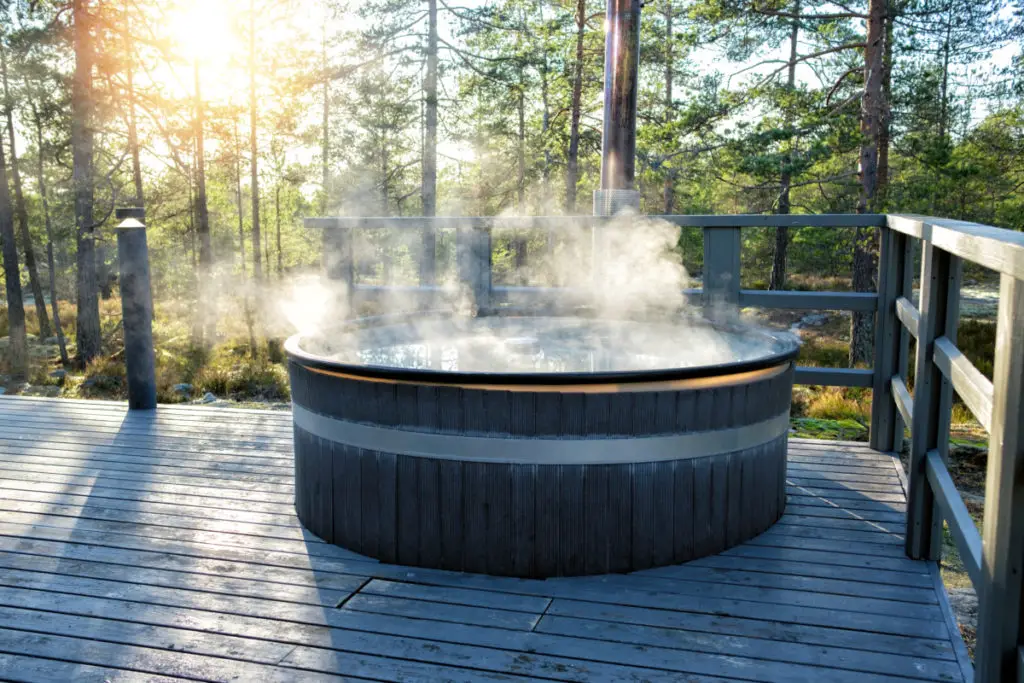This post contains affiliate links.

If your skin has ever been itchy after using a hot tub then you are like me. I have struggled with eczema and skin issues for the majority of my life. The irritation you experience after you use your hot tub can have many causes, but did you ever wonder if you could be having an allergic reaction?
There are chemicals used in hot tubs that can cause allergic reactions in individuals who are sensitive to them. Potassium peroxymonosulfate (PPMS) is a chemical used to shock hot tubs and has been medically documented to cause allergic reactions in humans.
There are other chemicals besides PPMS that can cause allergic reactions if used in hot tubs. Luckily there are ways to avoid these irritating chemicals and still enjoy your hot tub. Keep reading to find out how and what other chemicals may put you at risk.
Disclaimer: I am not a medical doctor and therefore am not giving medical advice. This information is not to be used as a substitute for medical advice by a licensed medical professional.
What Chemicals Can Cause Allergic Reactions?
Allergies to hot tub chemicals are rare but are something to consider if you have re-occurring symptoms such as rash, itching, or skin irritation after using a hot tub. Here are some common chemicals used in hot tubs that can cause allergic reactions in some people.
Potassium Peroxymonosulfate (PPMS)
PPMS is a chemical found in non-chlorine shock. A more common version of it is called MPS or Potassium Monopersulfate. It is used in hot tubs to help oxidize organics that have built up in the water from regular use. Check out my article about shocking hot tubs, where I talk about each type of hot tub shock if you would like to learn more about MPS.
While PPMS or MPS is great at helping sanitize your hot tub, it, unfortunately, can cause a nasty allergic reaction in a small portion of people.
A 2010 study by a group of dermatologists in Ohio found that a PPMS allergy was more common than previously thought. The group of doctors asked all of their patients who experienced generalized dermatitis over the course of a year about their hot tub use. Of the patients who routinely used hot tubs, they found six patients who could be medically diagnosed with an allergy to PPMS through a patch test.
Interestingly, all of those testing positive were male and in a similar age group between 45 and 80 years old. Avoiding PPMS caused improvement of symptoms in all diagnosed patients.
Until this study, there were only two documented cases of a PPMS allergy which means it is probably more common than previously thought.
Aluminum Chloride
Aluminum Chloride is a chemical used in flocculants. A flocculant is a technical term for a water clarifier. It causes small particles to clump together so they can be more easily removed through filtration and cleaning.
Aluminum Chloride is more commonly used in the pool industry but may be found in some hot tub clarifier products.
A 2012 study found that a 36-year-old swimming instructor experienced severe itching and rashes whenever she came in contact with pool water.
It was found that she was allergic to Aluminum chloride which is also commonly found in deodorants and cosmetic care products.
Chlorine And Bromine
It is a common thought that you can be allergic to chlorine and bromine. Luckily, you cannot be allergic to chlorine or bromine according to The American College of Allergy, Asthma & Immunology. Chlorine and bromine can be irritants as a result of a sensitivity to it, but your body will not have an allergic reaction to it.
Both these chemicals can cause respiratory problems, and skin irritation in those sensitive to them. I am one of those people, unfortunately.
What Are The Symptoms Of An Allergic Reaction?
The symptoms of an allergic reaction to a hot tub are going to depend on what chemical is causing the reaction. The most common symptoms will be itchiness, skin irritation, and rash. Depending on the severity of your allergy, the symptoms could be localized to an arm or leg, or more widespread.
In general, the only way to determine if you are indeed allergic to a chemical is to be tested by a medical professional. The symptoms mentioned above can be caused by many different conditions besides allergies.
It is important to note that allergens can cause a life-threatening condition called anaphylaxis. This condition requires immediate medical care and should be treated as an emergency.
What Are Alternatives If You Are Allergic To A Chemical Used In A Hot Tub?
If you are allergic to one of the chemicals mentioned in this article there are alternatives that will help you avoid contact with the chemical you are allergic to.
PPMS
If you are allergic to PPMS or MPS, then you will need to use an alternative shock product in your water maintenance routine. Luckily, you have a few options.
A chlorine-based shock will not have MPS as it uses a high dose of chlorine to oxidize the organics in the water. Unlike MPS-based shock, you will need to wait until the chlorine levels drop back to safe levels before you can use your hot tub again.
You could also use a calcium hypochlorite-based shock product. Unfortunately, this product is better for pool use where the temperature is much lower. Calcium hypochlorite breaks down rapidly at high temperatures so you will need to consider this if you decide to go this route.
Aluminum Chloride
If you are allergic to aluminum chloride you, unfortunately, will not be able to find another flocculant to use. Fortunately, flocculants are not usually needed in hot tubs so your best course of action will be to not use one altogether.
If you maintain your water chemistry and keep your filter clean, you should have no need for a water clarifier.
Chlorine And Bromine
As stated before you cannot be allergic to chlorine and bromine. But, if you do have a sensitivity to one and not the other you can use the one you are less sensitive to. Additionally, you can try to keep your exposure down to an absolute minimum by using a supplemental system that allows you to use extremely low levels of sanitizer.
I use a system called Frog @ease which allows me to keep my chlorine levels between 0.5 and 1.0 ppm. I am extremely sensitive to chlorine and have not had any issues at these levels.
If you are interested in learning more about alternative hot tub chemicals and low sanitizer levels, you can check out my article where I talk about both topics.
What Other Illnesses Can Be Caused By A Hot Tub?
Hot Tub Lung
Hot tub lung is caused by a bacteria called Mycobacterium avium complex (MAC). MAC thrives in warm water and is known to be capable of adhering to surfaces better than other types of bacteria.
The bacteria can hitch a ride on mist and steam rising from a hot tub and be inhaled by bathers where it infects the lungs. It can cause symptoms such as cough, difficulty breathing, fatigue, and fever.
This illness can be treated by a health care professional.
Hot Tub Rash
Hot Tub Rash or hot tub folliculitis is caused by the bacteria Pseudomonas aeruginosa. The rash is characterized by its itchy, red, or puss-filled blisters that primarily infect the hair follicles.
The bacteria can survive in warm water and generally infects areas where it is in contact the longest. If you suspect you have this type of infection, make sure you wash with soap and water and contact your health care professional.
Legionella Infection
Legionella bacteria cause the well-known illness called Legionnaires’ disease. Legionnaires is a type of pneumonia, which is a lung infection that causes fluid build-up that can be life-threatening.
Legionella thrives in warm water and can cause a serious illness. The bacterial is contracted through the inhalation of contaminated water droplets from the hot steam coming off of a hot tub.
Keeping the right levels of sanitizer in your hot tub and routinely draining to clean the hot tub can prevent contamination.
If you suspect you have a legionella infection you should contact a health care professional.
Urinary Tract Infection
Urinary Tract Infections can be caused by hot tubs and generally cause burning, itching, and painful urination. A properly managed hot tub should not cause a UTI.
If you have the symptoms of a UTI make sure you contact your health care professional.


